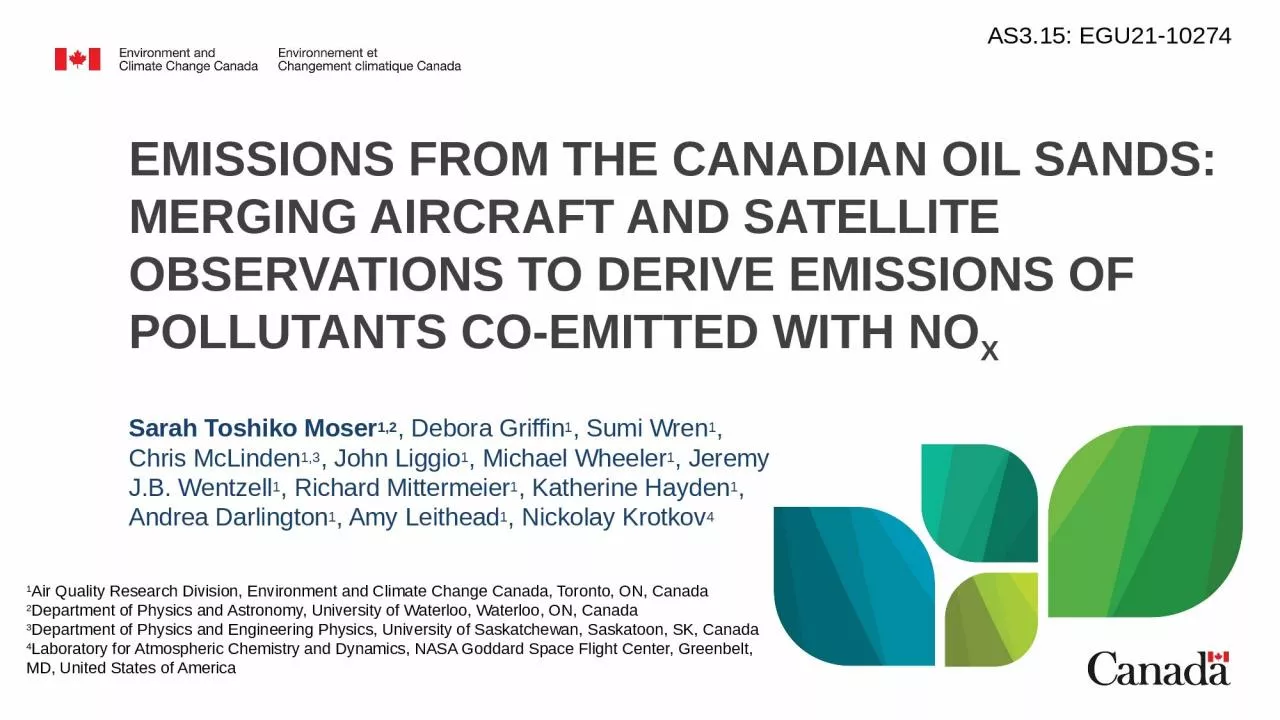

Merging aircraft and satellite observations to derive emissions of pollutants coemitted with NO x Sarah Toshiko Moser 12 Debora Griffin 1 Sumi Wren 1 Chris McLinden 13 John Liggio ID: 934304
Download Presentation The PPT/PDF document "Emissions from the Canadian oil sands:" is the property of its rightful owner. Permission is granted to download and print the materials on this web site for personal, non-commercial use only, and to display it on your personal computer provided you do not modify the materials and that you retain all copyright notices contained in the materials. By downloading content from our website, you accept the terms of this agreement.
Slide1
Emissions from the Canadian oil sands: Merging aircraft and satellite observations to derive emissions of pollutants co-emitted with NOx
Sarah Toshiko Moser1,2, Debora Griffin1, Sumi Wren1, Chris McLinden1,3, John Liggio1, Michael Wheeler1, Jeremy J.B. Wentzell1, Richard Mittermeier1, Katherine Hayden1, Andrea Darlington1, Amy Leithead1, Nickolay Krotkov4
1Air Quality Research Division, Environment and Climate Change Canada, Toronto, ON, Canada2Department of Physics and Astronomy, University of Waterloo, Waterloo, ON, Canada3Department of Physics and Engineering Physics, University of Saskatchewan, Saskatoon, SK, Canada4Laboratory for Atmospheric Chemistry and Dynamics, NASA Goddard Space Flight Center, Greenbelt, MD, United States of America
AS3.15:
EGU21-10274
Slide2Table of ContentsIntroduction
MethodologyBlack Carbon (BC)Carbon Monoxide (CO)Hydrogen Cyanide (HCN)Nitrous Acid (HONO)Sulfur Dioxide (SO2)ConclusionsGlossary
2
Slide3IntroductionAthabasca Oil Sands Region (
AOSR), Alberta contains large deposits of bitumenSources of air emissions from combustionMine fleet: heavy off-road trucks and excavatorsStacks: upgrade of bitumen to synthetic crude oilNOX emissions are well-known and monitored3Main facilities in AOSR – stack refineries are located in CNRL, SML, and SUNTable of Contents
Slide4IntroductionAircraft
can measure a large variety of species at a specific instance in time – including species not well-monitored and NOX (which is!)ECCC’s aircraft campaign over the AOSRAugust – September 2013, April – July 20182013: 22 flights, 2018: 30 flightsOver 60 species were measuredInstrumentsSingle Particle Soot Photometer (SP2)Thermo Scientific 43i-TLEPicarro G2401 analyzerThermo Scientific Model 42i-TL AnalyzerConvair 580 aircraft
4Flight path around SML from F02 in 2013 aircraft campaign
Source: Li et al., 2017, Figure S1
Image source:
Li, S
., et al.
(2017). Differences between Measured and Reported Volatile Organic Compound Emissions from Oil Sands Facilities in Alberta, Canada.
Proceedings of the National Academy of Sciences, 114
(19), E3756-E3765. https://
doi.org/10.1073/pnas.1617862114
Table of Contents
Slide5Research ObjectivesDetermine emissions of species over the
AOSR using NOX emissions combined with aircraft dataValidate inventories/reported emissionsBetter understand emissions of species not well-monitore5TROPOMI satelliteTable of Contents
Slide6Methodology
We expect good correlation between co-emitted species and NOX since they are both emitted from combustion processesAircraft in-situ measurements were background corrected to isolate facility emissionsPlotted species vs NOX, colour with SO2 for each individual facility in each flight (see figure)Split data into fleet/stack emissions with SO2Low SO2: fleetHigh SO2: stackAlso used BC and manual selection from the timeseries of the flight to separate
6Table of Contents
Fleet emissions
Stack emissions
Slide7Methodology
Combined all flights from one facility into one plot (see figure)Fit a line using a reduced major axis method to fleet and stack emissions separatelyRecorded slopes as ratio7
Fleet emissionsStack emissions
Table of Contents
Slide8Methodology
Calculated combined ratio (eqn. 1)Species emissions found by multiplying ratio by NOX emissions (satellite, reported, etc.) (eqn. 2)NOX emissions used:Satellite (TROPOMI, OMI)Reported (NPRI, AEP)Other ratios foundTERRA ratio (direct estimate from aircraft measurements)
where E is the TERRA estimate
Reported ratio (
) where E is the reported value
8
R = combined ratio
F = fleet ratio
S = stack ratio
a
= NO
X
mine fraction
E = species emissions
r = ratio (combined, TERRA, etc.)
Table of Contents
Slide9Black carbon (BC)
9KEY RESULTSEmission totals agree well with other methodsEmissions mostly from fleet – very little from stackInventory overestimates observed BCTable of Contents
Slide10Carbon Monoxide (CO)
10KEY RESULTSOnly one ratio observed – same ratio for fleet and stackData was binned to reduce effect of outliers – large standard deviationSML overestimates compared to other methodsTable of Contents
Slide11Hydrogen Cyanide (HCN)
11KEY RESULTSPreliminary resultsOnly one ratio observed – same ratio for fleet and stackNo reported emissions to compare toSUN agrees well with other methodsPossible reason for discrepancy: TERRA did not find many fleet emissionsTable of Contents
Slide12Nitrous Acid (HONO)
12KEY RESULTSPreliminary resultsOnly one ratio observed – same ratio for fleet and stackNo reported emissions to compare toSML and SUN emissions are within a standard deviation of each otherTable of Contents
Slide13Sulfur Dioxide (SO2)
13KEY RESULTSNo fleet emissions observed – only emissions from stackCNRL agrees well with the other methodsSML and SUN agree with reported emissionsTable of Contents
Slide14ConclusionsCorrelations method agrees well with other methodsImproves time-efficiency since this method is faster than using TERRA
The method is a good way to determine emissions of species that aren’t well-monitored14Table of Contents
Slide15GlossaryAOSR: Athabasca Oil Sands Region
NOx: pollutant comprised of NO and NO2ECCC: Environment and Climate Change CanadaNPRI: National Pollutant Release Inventory (reported stack emissions)AEP: Alberta Environment and Parks (reported fleet emissions)TROPOMI: TROPOspheric Monitoring InstrumentOMI: Ozone Monitoring InstrumentTERRA: Top-down Emission Rate Retrieval AlgorithmCNRL: Canadian Natural Resources Limited Horizon (facility in AOSR)SUN: Suncor Millenium and Steepbank (facility in AOSR)SML
: Syncrude Mildred Lake (facility in AOSR)IKL: Imperial Kearl Lake (facility in AOSR)
15
Table of Contents